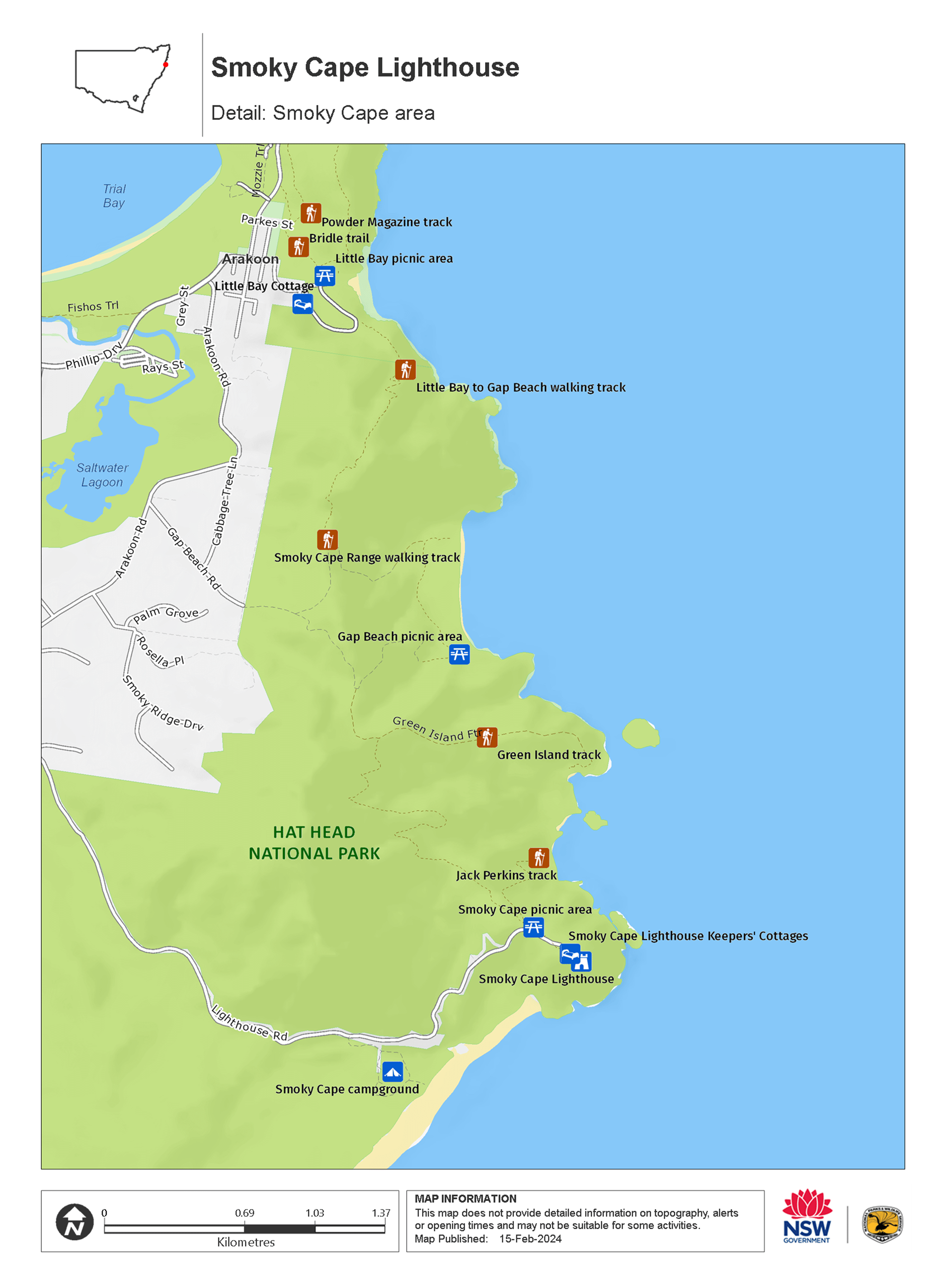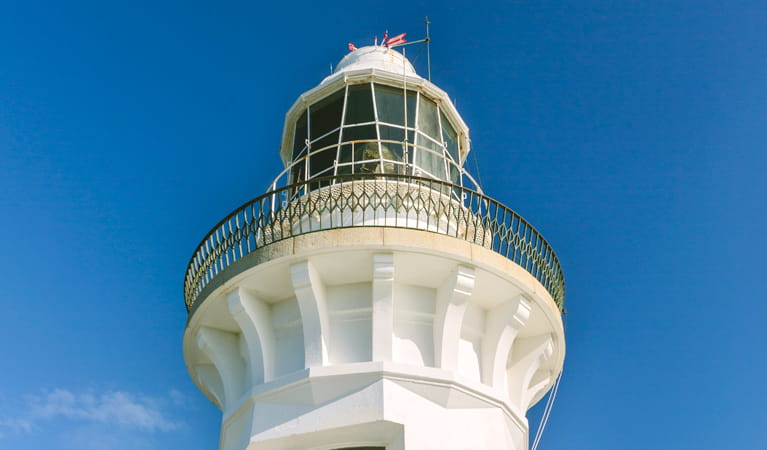Smoky Cape Lighthouse
Hat Head National Park
Overview
Hat Head National Park on the mid-north coast of NSW near South West Rocks is a natural paradise. Explore the lighthouse, camp by the beach and go fishing and swimming.
- Type
- Historic buildings/places
- Where
- 446 Lighthouse Road, Arakoon, NSW, 2431 - in Hat Head National Park in North Coast
- Entry fees
- Park entry fees apply
- Please note
It’s a short but steep climb to the lighthouse – be sure to wear sturdy shoes.
Standing high on a narrow headland, Smoky Cape Lighthouse is surrounded by the stunning coastal scenery of Hat Head National Park. The lighthouse itself is as beautiful as the views – check out its winding staircase and octagonal tower.
Built in 1891, this heritage lighthouse is one of the last designed by the Colonial Architect, James Barnet. Smoky Cape headland was so named by Captain Cook after he saw Aboriginal fires burning there in 1770.
Smoky Cape is a fantastic spot for whale watching, birdwatching and picnicking, and you can stay overnight at the lighthouse keepers’ cottage. Don’t miss the views at nearby Smoky Cape picnic area.
Map

Map legend

Local alerts
For the latest updates on fires, closures and other alerts in this area, see https://www.nationalparks.nsw.gov.au/things-to-do/historic-buildings-places/smoky-cape-lighthouse/local-alerts
General enquiries
- National Parks Contact Centre
- 7am to 7pm daily
- 1300 072 757 (13000 PARKS) for the cost of a local call within Australia excluding mobiles
- parks.info@environment.nsw.gov.au
Park info
- in Hat Head National Park in the North Coast region
Hat Head National Park is always open but may have to close at times due to poor weather or fire danger.
-
Park entry fees:
$8 per vehicle per day.
Buy annual pass.
Visitor info
All the practical information you need to know about Smoky Cape Lighthouse.
Getting there and parking
Smoky Cape lighthouse is in the Smoky Cape precinct of Hat Head National Park. To get there:
- Take Arakoon Road from South West Rocks
- Turn into Lighthouse Road and follow the signs to Smoky Cape Lighthouse
Road quality
- Sealed roads
Vehicle access
- 2WD vehicles
Weather restrictions
- All weather
Parking
Parking is available at the nearby Captain Cook’s lookout.
Best times to visit
This park's sweeping beaches are extremely inviting during summer, but its wildlife and walking tracks make it a joy to visit all year round.
Spring
A birdwatcher's delight as the heath shrubland bursts into a kaleidoscope of wild flowers and birds come from all around, listen out for the guttural call of glossy black cockatoos.
Summer
Take a coastal bushwalk to experience wildflower displays amongst the banksias.
Winter
Spot humpback and southern right whales migrating to northern waters between May and July.
Weather, temperature and rainfall
Summer temperature
Average
19°C and 26°C
Highest recorded
41.7°C (1968)
Winter temperature
Average
13°C and 20°C
Lowest recorded
4°C (1997)
Rainfall
Wettest month
March
The area’s highest recorded rainfall in one day
343.7mm
Maps and downloads
Prohibited
Pets
Pets and domestic animals (other than certified assistance animals) are not permitted. Find out which regional parks allow dog walking and see the pets in parks policy for more information.
Smoking
NSW national parks are no smoking areas.
Learn more
Smoky Cape Lighthouse is in Hat Head National Park. Here are just some of the reasons why this park is special:
A long story to tell

The park is part of the traditional land of the Dunghutti people and remains a significant place. The sea, rivers and wetlands provided a rich source of food like fish and shellfish and the strong Aboriginal heritage is evident today. The park is culturally important to Aboriginal people as it contains ceremonial grounds, burial sites, shell middens and campsites.
A place to play

Hat Head National Park protects an extraordinary amount of landscapes, birds and animals, but also offers countless opportunities for secluded relaxation, recreation and enjoyment. Sweeping beaches, rainforests, impressive dunes, and rocky headlands make it the perfect holiday or day trip for walking, swimming, hiking, bird watching and fishing.
- Green Island walking track Green Island walking track goes through coastal heathland to a lookout with scenic views to Smoky Cape Lighthouse, offering excellent birdwatching and whale watching.
- Smoky Cape Lighthouse Hat Head National Park on the mid-north coast of NSW near South West Rocks is a natural paradise. Explore the lighthouse, camp by the beach and go fishing and swimming.
Biodiversity

Hat Head National Park is rich with birdlife such as black swans, egrets, herons, fantails, and honeyeaters. If you’re lucky, you might even spot a hawk, falcon or eagle soaring above the cliffs. During the spring, you might catch a rare glimpse of a glossy black cockatoo - listen out for the raucous call of this endangered species as it visits the park to feed on ripe she-oak fruit seeds. Resident wildlife at Hat Head includes red-necked and swamp wallabies as well as grey kangaroos and sugar gliders. You're bound to see butterflies fluttering past you in Hat Head National Park. One type, the regent skipper, is only found in Hat Head National Park and Limeburners Creek National Park. With black wings and a range of yellow and red dots and stripes, you might see the regent skipper feeding on tuckeroos in the park's rainforest.
- Little Bay to Gap Beach walking track Little Bay to Gap Beach walking track is a challenging walk offering birdwatching, swimming, fishing and scenic views in Hat Head National Park, near South West Rocks.
Striking landscapes

Some of the largest in New South Wales, the park's enormous sand dunes can't help but catch your eye. The dunes provide a buffer from the ocean, protecting the land from salty winds and waves. They are slowing growing and moving inland, gradually taking over the park's wetlands. See if you can make it to the top of the dunes - you'll get a bird's eye view and feel like you're on top of the world.
- Smoky Cape Lighthouse tour Walk alongside a NPWS ranger on a fascinating tour of Smoky Cape lighthouse, the highest lighthouse in New South Wales. Take in the stunning coastal scenery along the way.
- Smoky Cape Range walking track Discover the beauty of the South West Rocks region on the Smoky Cape Range walking track. Hike this 5.5km coast walk and enjoy sensational views.
Plants and animals protected in this park
Animals
-

White-bellied sea eagle (Haliaeetus leucogaster)
White-bellied sea eagles can be easily identified by their white tail and dark grey wings. These raptors are often spotted cruising the coastal breezes throughout Australia, and make for some scenic bird watching. Powerful Australian birds of prey, they are known to mate for life, and return each year to the same nest to breed.
-

Kookaburra (Dacelo novaeguineae)
Of the 2 species of kookaburra found in Australia, the laughing kookaburra is the best-known and the largest of the native kingfishers. With its distinctive riotous call, the laughing kookaburra is commonly heard in open woodlands and forests throughout NSW national parks, making these ideal spots for bird watching.
-

Short-beaked echidna (Tachyglossus aculeatus)
One of only 2 egg-laying mammals in the world, the short-beaked echidna is one of the most widespread of Australian native animals. Covered in spines, or quills, they’re equipped with a keen sense of smell and a tube-like snout which they use to break apart termite mounds in search of ants.
-

Green and golden bell frog (Litoria aurea)
The green and golden bell frog is an endangered Australian frog. Once common on the NSW coast and tablelands, populations have plummeted around 90 percent.
Plants
-

Black sheoak (Allocasuarina littoralis)
The black sheoak is one of a number of casuarina species found across the east coast of Australia and nearby tablelands. Growing to a height of 5-15m, these hardy Australian native plants can survive in poor or sandy soils. The barrel-shaped cone of the black sheoak grows to 10-30mm long.
-

Grass tree (Xanthorrea spp.)
An iconic part of the Australian landscape, the grass tree is widespread across eastern NSW. These Australian native plants have a thick fire-blackened trunk and long spiked leaves. They are found in heath and open forests across eastern NSW. The grass tree grows 1-5m in height and produces striking white-flowered spikes which grow up to 1m long.

